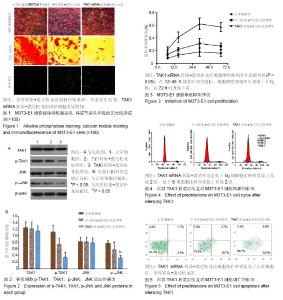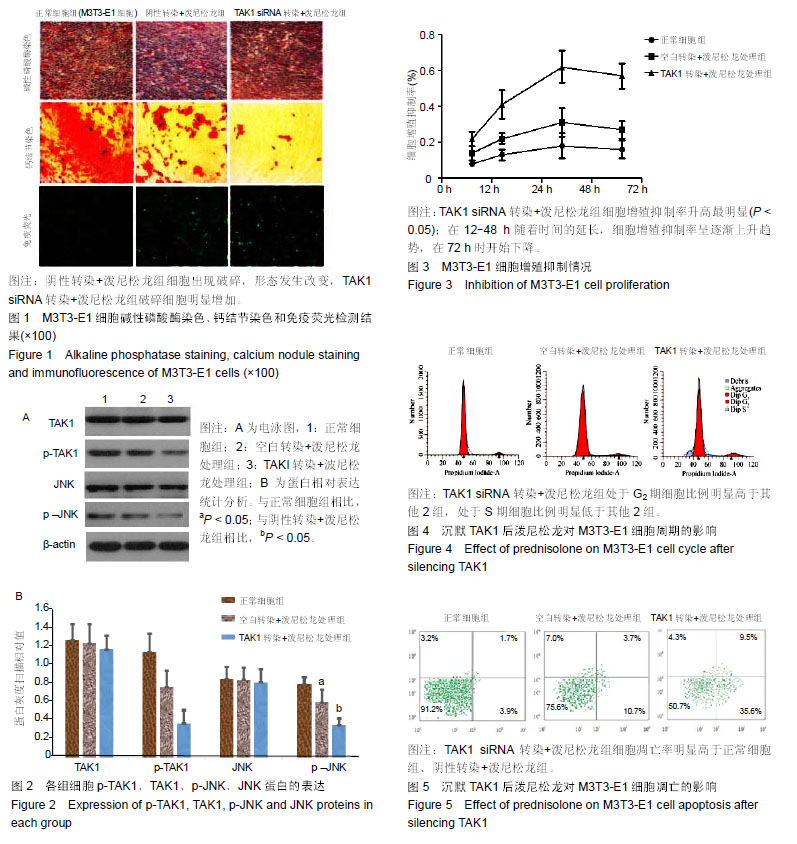| [1]韩亚军,帖小佳,伊力哈木•托合提.中国中老年人骨质疏松症患病率的Meta分析[J].中国组织工程研究, 2014,18(7):1129-1134.[2]许争光,杨峻,吕志平,等. 芫花根醇提颗粒联合甲基泼尼松龙对脊髓损伤大鼠BDNF、NMDA表达及行为学的影响[J].中国中西医结合杂志, 2015,35(8):1004-1010.[3]张琪琪,胡勇,周定,等.ADAMTS-4与TAK1在骨关节炎软骨组织中表达的相关性研究[J].安徽医科大学学报, 2014,49(3): 343-346.[4]冯世尧,徐兴欣,邵云侠,等. TAK1信号通路在高糖诱导骨髓来源巨噬细胞激活中的作用[J].中华肾脏病杂志, 2016,32(1):37-42.[5]Ismail HM,Didangelos A,Vincent TL,et al.Articular cartilage injury rapidly activates TAK1 in chondrocytes by inducing its phosphorylation and K63-polyubiquitination. Arthritis Rheumatol. 2017;69(3):565-575. [6]程锦,胡晓青,段小宁,等.转化生长因子β活化激酶1诱导软骨细胞发生骨关节炎相关病变机制[J].中国生物化学与分子生物学报, 2016, 32(12):1326-1333.[7]宋志刚. 不同剂量甲基泼尼松龙治疗急性脊髓炎的效果对比[J].中国急救医学, 2016, 36(1):114-115.[8]崔健超,杨志东, 江晓兵,等.泼尼松龙与地塞米松介导腰椎骨量降低的差异及其对成骨成脂基因表达的影响[J].中国脊柱脊髓杂志, 2015, 25(2):168-173.[9]Chen Z, Xue J, Shen T, et al. Curcumin alleviates glucocorticoid-induced osteoporosis by protecting osteoblasts from apoptosis in vivo and in vitro. Clin Exp Pharmacol Physiol.2016;43(2):268-276.[10]袁赤亭,朱敏,范利荣,等.糖皮质激素受体在3种人成骨肉瘤细胞株MG63、U2-OS及HOS中表达及差异[J].医学研究杂志, 2014, 43(11):144-146.[11]粱军波,徐春丽,潘伟波,等.高血糖对成骨细胞增殖分化影响的实验研究[J].医学研究杂志,2012, 41(3):117-120.[12]任辉,魏秋实,江晓兵,等.糖皮质激素性骨质疏松的研究新进展[J].中国骨质疏松杂志, 2014,20(9):1138-1142.[13]Wang FS,Wu RW,Ko JY,et al.Heat shock protein 60 protects skeletal tissue against glucocorticoid-induced bone mass loss by regulating osteoblast survival. Bone. 2011;49(5): 1080-1089.[14]Suzuki A, Takayama T, Suzuki N, et al.Daily low-intensity pulsed ultrasound-mediated osteogenic differentiation in rat osteoblasts. Acta Biochim Biophys Sin (Shanghai). 2009; 41(2):108-115. [15]Zhou C,Zhang X,Xu L,et al.Taurine promotes human mesenchymal stem cells to differentiate into osteoblast through the ERK pathway. Amino Acids, 2014, 46(7): 1673-1680.[16]刘化刚,王春,谷天祥,等. 转化生长因子-β1/TGFp激活激酶信号表达变化在心房颤动心肌纤维化中的作用[J].中国心血管病研究, 2012, 10(12):932-936.[17]Pathak S,Borodkin VS,Albarbarawi O,et al.O -GlcNAcylation of TAB1 modulates TAK1-mediated cytokine release. EMBO J. 2012;31(6):1394-1404.[18]潘建科,曹学伟,刘军,等.龙鳖胶囊对骨关节炎软骨细胞p38MAPK信号通路及NF-κB p65的影响[J].中国组织工程研究, 2016, 20(46):6868-6877.[19]欧阳春,张里克,卢远航,等. TAK1抑制剂对糖尿病大鼠MAPK与NF-κB信号通路的影响及其对肾脏保护机制[J]. 中国比较医学杂志, 2017, 27(1):67-72.[20]Kerzic PJ, Pyatt DW, Zheng JH, et al.Inhibition of NF-kappaB by hydroquinone sensitizes human bone marrow progenitor cells to TNF-alpha-induced apoptosis.Toxicology. 2003;187(3): 127-137.[21]Duan J,Yu Y,Yang L,et al.Toxic Effect of Silica Nanoparticles on Endothelial Cells through DNA Damage Response via Chk1-Dependent G2/M Checkpoint. Plos One.2013; 8(4): 62087-62093.[22]Ji Y,Dou Y,Zhao Q,et al.Paeoniflorin suppresses TGF-β mediated epithelial-mesenchymal transition in pulmonary fibrosis through a Smad-dependent pathway.Acta Pharmacologica Sinica.2016; 37(6):794-804.[23]Liao PC, Lieu CH. Cell cycle specific induction of apoptosis and necrosis by paclitaxel in the leukemic U937 cells. Life Sciences.2005; 76(14):1623-1639.[24]袁芳,何晓瑾,邱亦江,等. 骨关节炎的软骨细胞凋亡机制[J]. 实用医学杂志, 2015, 31(4):666-668.[25]徐晓东,邓洋洋,郑洪新. 糖皮质激素诱导肾虚骨质疏松症大鼠骨组织中OPG/RANKLmRAN及蛋白表达的影响[J].中华中医药学刊, 2013,31(12):2623-2627.赵硕,李成. 糖皮质激素通过线粒体途径诱导成骨细胞凋亡[J].中国生化药物杂志,2015,35(7):35-38. |

